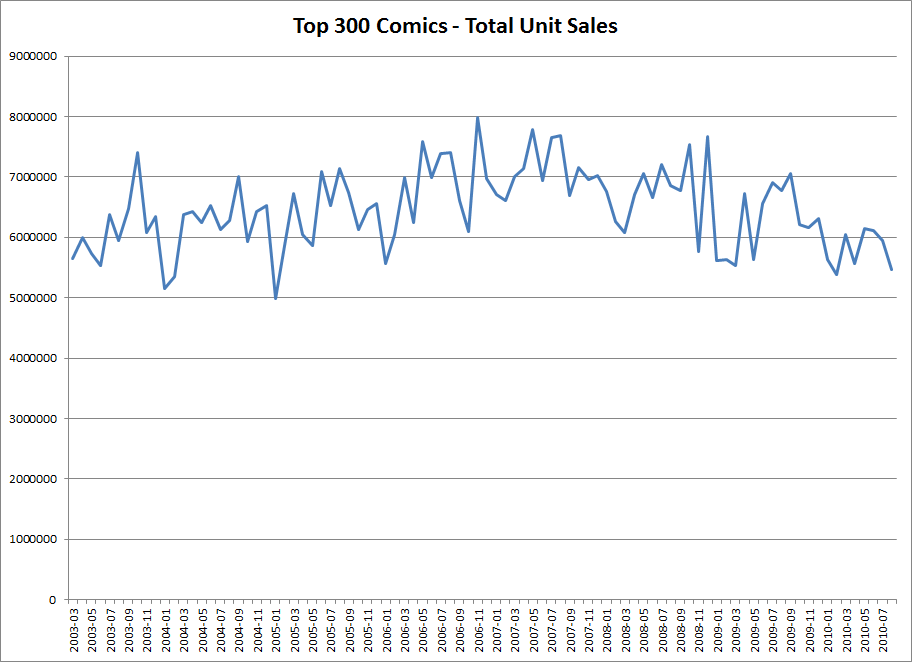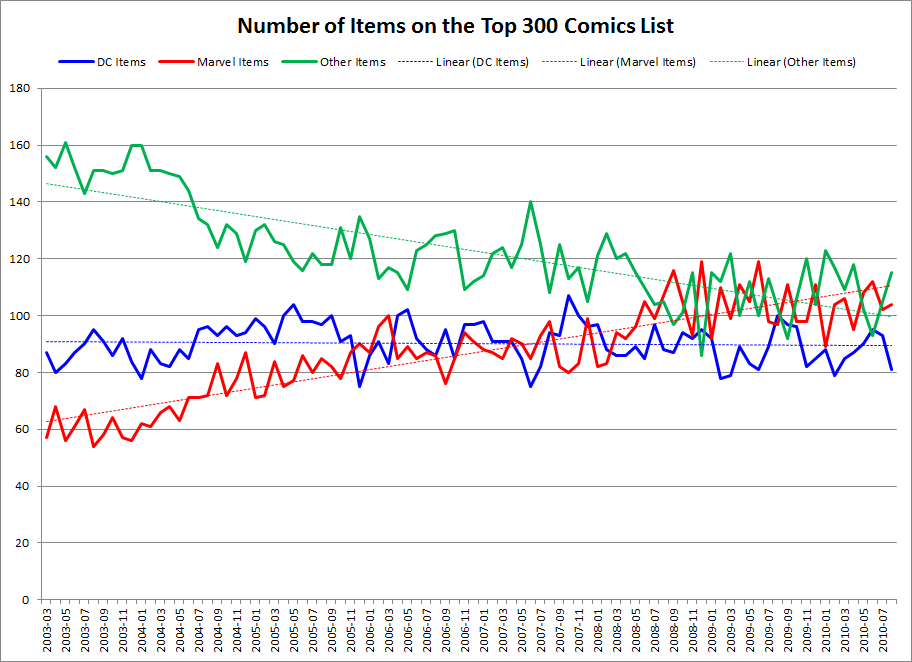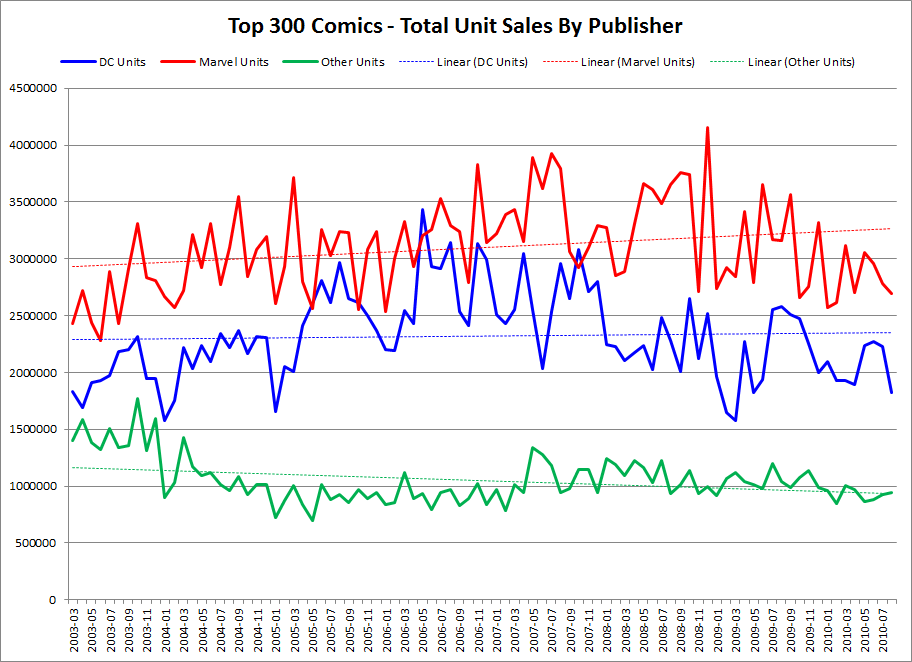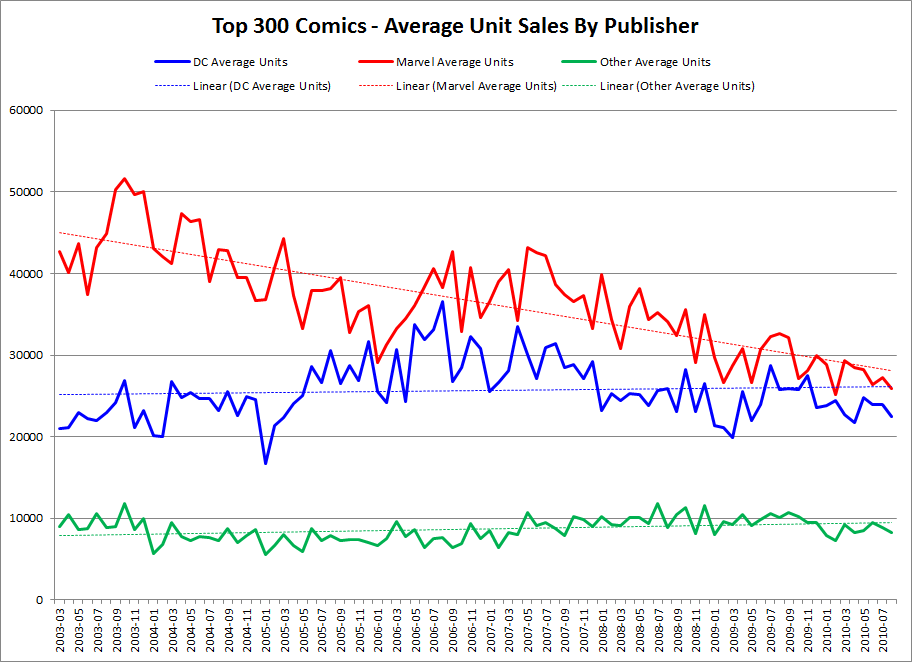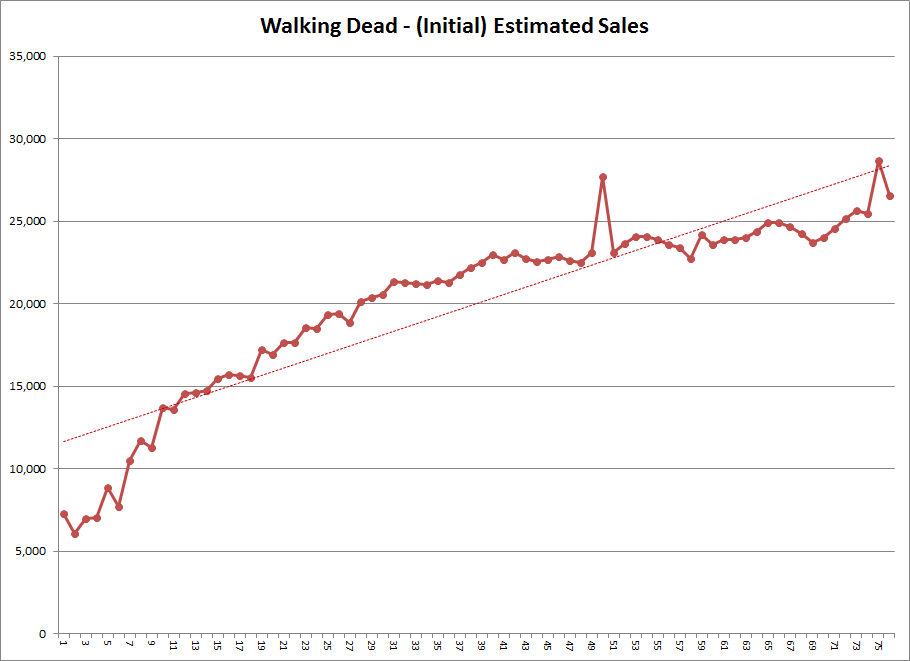Mayo Report for 2010-08

|
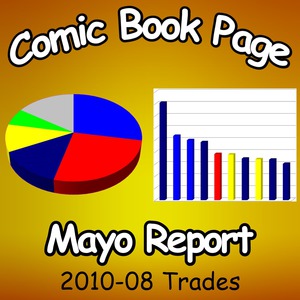
|
Top Comics List Top Comics Breakdown Top Trades List Top Trades Breakdown
August 2010 had the fifth lowest number of total units sold for the top 300 comics since the start of the final order era (which started in March, 2003) with no comics selling over 100,000 units. All in all, it was not a great month for comic book sales. But don't panic. This chart illustrates that while sales were down in August, the overall sales of new comics isn't much worse than it has been over the past few years.
August isn't usually a down month for comic book sales in the direct market like is usually the case in January. During the final order era, August has typically been the fourth strongest month of the year for new comic book sales.
So, what happened?
For one thing, there were no major line-wide crossover events at Marvel or DC. Not only does this remove the blockbuster sales of the event series itself, the numerous side mini-series all recent events seem obligated to have but also the boost in sales for the tie-in issues of the monthly titles. This trifecta has been one of the things propping up sales for the past few years. Such events have not only brought in sales of over 100,000 units on a regular basis but the side mini-series supporting the event typically accumulate a respectable amount of sales as well. The sales boost from these tie-in issues of monthly titles can be any were from a few thousand units to a doubling or, on rare occasion, tripling of sales for the tie-in issues. This surge of sales from a major line wide event is often doubled since DC and Marvel have often each had such events running concurrently over the past few years.
Another factor is there were no major new titles launching in August. Most of the earlier months in the year had a high profile launch doing over 100,000 units such as "Siege" in January, "Flash" in April, "New Avengers" in June and "X-Men" in July. The big month for launches this year was May with "Avengers," Batman: Return of Bruce Wayne" and "Secret Avengers." ("Brightest Day" #1 which also shipped in May was technically the second issue of that title). With "Brightest Day" #7 selling approximately 93,459 units and topping the list in August with those sales, it is no wonder the overall sales for the month came in low. Usually there are two or three items with stronger sales each month. The promotional push that accompanies these new launches certainly contributes to the sales but it is the perceived jumping-on point aspect which is the main draw for these issues.
The highest ranked launch in August was "Green Lantern: Emerald Warriors" #1 at with an estimated 68,332 units which put it a little over 1,200 units above "Green Lantern Corps" #51 in July. (No issue of "Green Lantern" shipped in August.) Comparing the sales of "Green Lantern: Emerald Warriors" #1 to the 140,332 units sold by "X-Men" #1 in July illustrates how much a difference a single strong launch can make to the total sales for a month. Comparing the sales of "Green Lantern: Emerald Warriors" #1 to "X-Men" #1 might seem like an odd or unfair comparison but both launches are tied into a major storyline for an established franchise and extend the franchised to a third ongoing monthly title. One major difference is that "X-Men" #1 was the start of a major storyline for the X-Men franchise while "Green Lantern: Emerald Warriors" was not the start of any such new storyline but the continuation of an existing storyline.
It is worth pointing out "X-Men" #2 sold around 71,464 units which, once the estimated 2,835 units of reorder activity is factored in, is just under half the sales of that first issue. While that is by far the largest drop in terms of the number of units, it isn't the largest percentage drop for the month. That distinction goes to "Hit Monkey" which suffered a drop of 63.45% from an estimated 27,129 units for the first issue to just 9,916 units for second issue.
Even with that drop and those low sales, "Hit Monkey" #2 still managed to land in in rank 155 on the top 300 comics list in August which means nearly half the list did even worse. The lowest selling title set in the DC Universe was "Magog" #12 at approximately 6,202 units. Unsurprisingly, that was the final issue of that monthly series. The lowest selling issue of a monthly title set inside the Marvel Universe in August was "Atlas" #4 with an estimated 13,205 units. There were a few other comics set in the mainstream Marvel continuity that sold less: "Amazing Spider-Man Presents American Son" #4 with 13,128 units, the "Spitfire" one-shot with 9,926 units, the previously mentioned "Hit Monkey" #2 with 9,916 units, "Gorilla Man" #2 with 7,744 units and "Darkstar and the Winter Guard" #3 with 6,716 units. All of those were either one-shots or limited series. Even if they had launched as ongoing titles, odds are those titles would have quickly been converted into limited series. This casts into serious doubt there being any sort of synergistic boost from setting a story inside either of the largest and most successful narrative universes in comics.
The take away is that even though Marvel often accounts for around half the sales of the top 300 comics, there are a number of Marvel titles selling shockingly low numbers. DC has a number of equally low selling titles. Gone are the days when every comic shop stocked every issue of every Marvel and DC comic. Smaller publishers have an even rougher time of it. Both Marvel and DC are publishing a large number of titles. Over the last few years, DC has accounted for around 90 items on the list each month. During that same time, Marvel has gone from around 60 items on the list to nearly twice that.
Compare that to the overall sales for DC, Marvel and everyone else for the same time range:
Note that DC has remained fairly stable in sales for the top 300 comics while staying fairly constant in the number of items on the list. Marvel, on the other hand, has only increased slightly in overall sales while they nearly doubled the number of items they had on the list. The result is, on average, Marvel titles are selling worse than they had been a few years ago.
The most distressing aspect of this is it implies the usually employed techniques of boosting sales, while effective on the specific issues they are used on, aren't working out in the long run.
One technique used to boost sales is re-launching a title. A recent example of this is the new "New Avengers" #1 in June which boosted sales by well over 50,000 units over the sales of the final issue of the previous "New Avengers" series. Over 45,000 of those units were lost by the second issue and another 2,000 units with the third issue. The new "New Avengers" series is now selling around the level the previous series was selling in September, 2009.
Consider the implications for a moment. The title is re-launched with a new #1 issue and within three issues about 95% of the sales boost is gone. Short term this is good, but it isn't doing anything for the long term. Of course, these days, many titles only last for a handful of issue so maybe long term thinking isn't as necessary in today's market. The problem with that reasoning is it turns comics into a churn based market. At the end of each mini-series, the reader is given a very clear jumping-off point and has to be sold on jumping-on to the next mini-series. And it is always easier and more likely for a reader to jump-off a title than to jump-on to a title.
For examples of the short term effectiveness of event tie-in issues, we need only look at the recent Blackest Night tie-in issues (both those with the promotional Power Rings and those without) to see that the sales boost gained by the tie-in was completely gone within an issue or two. This directly mirrors what happened during many events in recent years with Civil War being an excellent example over at Marvel. The lesson here is there are ways to get massive increases in sales on particular issues but converting that into a sustained increase in sales which lasts for any meaningful length of time usually doesn't happen.
But none of this was new in August, or new in 2010 for that matter. There have been months without strong launches of new titles before. There have been months without major crossovers before. There have been re-launches of titles before. This constant turnover in titles, both ongoing and mini-series is nothing new either. But just because it isn't new doesn't mean it isn't a problem.
Event, multiple covers, re-launches and other sales techniques have been bolstering the short terms sales and hiding the long term problems. The monthly comic book sales have become like a growing forest of dying trees. New titles are launching at what would have been cancelation levels just a few years ago. Sales of ongoing titles have been sliding issue after issue for years. It seems as if the budgets of the readers and retailers aren't as deep as the publishing lines are wide. There are too many titles which are too indistinguishable from and too interwoven with each other. Nothing makes each individual title unique and able to stand alone. This leaves readers feeling they have the choice to get all of the titles in the group or none of them.
But it doesn't have to be this way. Sales should be staying even or going up on most titles. Currently, there is only one title consistently increasing in sales issue after issue: "Walking Dead."
Publishers, editors and creators need to learn from Robert Kirkman's success. Comics could and should tell stories so gripping and entertaining they sell themselves. The stories should be so accessible that you can jump-in with any issue, not just every sixth issue. Each issue should have enough story content people never question if they got their money's worth. The goal for each issue should be to pre-sell the following issue.
The problem isn't the total sales of new comics for the top 300 comics were down in August. The problem is the sales on most of the titles in the top 300 comics were down. The problem needs to be fixed on the individual titles and it can be. The question is not if but when the core problems causing the accepted "standard attrition" in sales will be fixed and how many comic book readers will be around when that happens.

